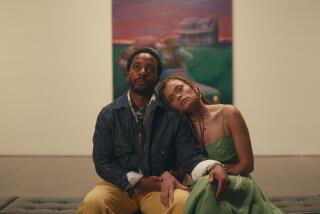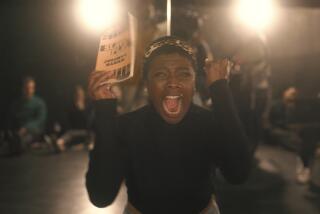Cultural Exchange: ‘Exhibit A’ at National Arts Festival stirs emotion through racism
- Share via
GRAHAMSTOWN, South Africa — Of all the work presented at this year’s National Arts Festival, one of the art world’s better-kept secrets, a piece by conceptual theater artist Brett Bailey drew some of the most eager gazes. But audiences quickly averted their eyes when the horrors of the work became known.
That’s because “Exhibit A” showed them something almost unimaginable — a human zoo.
Throughout the 19th century and well into the 20th, colonial conquest of southern Africa yielded not just land and goods; it led to the discovery of what Europeans considered a new “subspecies” of man: black Africans. Many were captured and shipped to Europe, where they were exhibited, animal-like, for millions. Sara Baartman, a woman from this region of South Africa, was the most famous of these freak-show attractions, her much-documented time as an exotic showpiece on London stages is still a source of inspiration for contemporary artists exploring issues of racism.
“Exhibit A” is Bailey’s re-imagining of these colonial-era spectacles. Using a run-down school building as a site for the installation, he created a mock museum, through which spectators could comfortably wander. Or not so comfortably, as the case turned out to be.
In every room — lights low, shadows heavy, dead leaves crunching underfoot — living, breathing African men and women were on display, complete with info placards explaining their origins in dehumanizing, scientific terms. But that wasn’t even the exhibit’s most challenging part. Every time you looked one of the “specimens” in the eye, you would confront a fierce, incriminating, desperately sad look back. You stared only if you dared.
“I couldn’t look at them” became the common refrain of exiting spectators, often admitted between sobs.
“You’re seduced by beauty. You want to look,” said Bailey. “But the content is so horrific that you don’t want to look at the same time. You don’t know where to look. That’s strange — two levels. Somehow you’ve got to find yourself in between the two.”
Anton Krueger, a theater scholar who moderated a discussion with the fast-talking, digressive Bailey, said the core emotional response to Exhibit A was shame. “It’s not a very popular emotion, as they go,” Krueger said. “It’s not something they put on the logline of a movie: ‘Come and be ashamed. Feel guilty.’ But because it’s so beautiful, we have this aesthetic experience. It’s some richer feeling of shame.”
In his talk, Krueger echoed the oldest criticism of Bailey’s work when he called him, sarcastically, “the white guy who’s playing with black people again.” But Bailey, one of this country’s best-known creative risk-takers, has an explanation.
The white side of Bailey’s family came here from Europe in 1674. “They were probably slave owners,” he said. “They were complicit in everything that’s happened here. My people have been immensely enriched by the atrocities here.” For Bailey, “Exhibit A” became his way of unraveling that — of finding and coming to terms with “the images that I was fed, that my ancestors were fed, in order to perpetuate this myth that one is better than the other.”
That could be achieved, he realized, only if he went for a more personal audience experience. Where once he believed in the powers of sensory overload and art-induced collective catharsis — massive spectacle, with drums beating, smoke swirling, music blaring — now his interest would be more intimate. (He and his Cape Town-based company, Third World Bunfight, still put on big shows, like 2009’s Africanized production of “Orfeus.”)
“Exhibit A” is essentially a one-on-one experience: you against them. What complicates that relationship, however, is the role reversal. By giving his actors the power of the gaze, Bailey said, he victimizes the spectator as he empowers the spectacle. As he told his actors during rehearsal: “You are the audience, they are the performers.”
Those dozen or so actors were selected carefully. For auditions, Bailey had them explain their own experiences with prejudice and racism. Many were transformed by the experience, becoming more confident in themselves and their bodies, he said.
Much of the work at this year’s arts festival drew on themes of oppression. A much-anticipated dance show called “Moffie” (an Afrikaans slur for a gay man) dealt with the experiences of a white, gay teenage boy conscripted into the South African army in the mid-’80s. “Mother to Mother” told the story of the mother of an African man involved in the 1993 murder of American Fulbright scholar Amy Biehl. In “Mies Julie,” an adaptation of the Strindberg play, race relations play out on a farm in the Karoo.
“Exhibit A” opened in Vienna’s Museum of Ethnology in 2010, where audiences were predominantly European. But the move to Africa complicated that message. Now it would be Africans on Africans, suggesting an altogether different viewing experience and possibly a darker one. That dynamic will change again as “Exhibit A” makes touring stops in Amsterdam, Ghent, Belgium, and Paris.
Bailey, for his part, isn’t one to dwell on deeper points of meaning. When Krueger asked him to situate his work between philosophical notions of familiarity and strangeness — concepts explored by past theater-makers like Bertolt Brecht — Bailey was quick to respond: “I don’t understand the question.” Everyone laughed, but part of him was serious. There’s a sense that talking too much about his work spoils it in some way. Bailey saw that in people’s reactions to “Exhibit A.”
“People come out, a lot of people are crying, people are very moved, people like to sit quietly. It’s interesting to watch,” said Bailey, who’s been known to hide out at his own shows and talk to spectators. “There’s a chatter going in, and then there’s an isolation and quietness when people come out.”
More to Read
The biggest entertainment stories
Get our big stories about Hollywood, film, television, music, arts, culture and more right in your inbox as soon as they publish.
You may occasionally receive promotional content from the Los Angeles Times.










